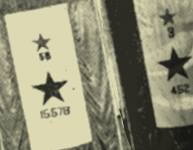 |
 |
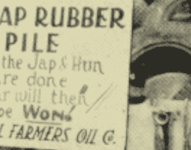 |
| Illinois
Farm Bureau and World War II |
|
The United States was catapulted into the Second World War following the raid on Pearl Harbor. This presentation gives some historical backdrop by looking at two speakers at the Annual Meeting just prior to Pearl Harbor and to the attack on Pearl Harbor itself. Then it will focus on some of the major impacts that the War had on Illinois Farm Bureau and its member companies during 1942 (the first full year of American involvement). |
| At the 26th Annual Meeting, held in St. Louis in January of 1941 the IAA delegates voted in favor of moving the date of the next Annual Meeting from its usual spot in January to the end of November. On November 27th, 1941, the delegates were reaping the benefit of that decision because the skies were clear and the temperature reached nearly 60 in Springfield. Many of the delegates to the 27th Annual Meeting stayed at the Abraham Lincoln Hotel and the general sessions were held at the Springfield Armory. The skies may have been sunny, however a somber and serious tone prevailed over the 4,000 delegates in attendance. IAA President Earl C. Smith addressed the delegate body, to give his annual address, for the 16th time that Thursday morning. The following day he was elected for a 17th term. In his address, President Smith called for national unity. He said… "It is time that the Leaders of our Nation, as well as all citizens, recognize that the greatest and strongest bulwark of democracy and its defense is the unity of the people. The present crisis calls for statesmanship of the highest order. Politics should and must be adjourned." The "present crisis" Smith referred to was the war raging in Europe and Asia, the assault on free nations by totalitarian rulers. In his address President Smith also challenged labor to pledge a moratorium on any and all work stoppages and strikes. He covered numerous state and national legislative issues including the increased bureaucracy, partisan politics and inefficiency that he saw evident within the administration of the AAA (the Agricultural Adjustment Act). But in light of history President Smith's most poignant, almost prophetic remarks came at the close of his address. He ended his speech with these words. "Farmers would live at peace with all groups. They ask for no economic goal that they would not commend to others. They will eagerly share with others any needed sacrifice for their country and they are ready, with others, to defend with force, if need be, American ideals and American institutions. "Never have American farmers been confronted with such gigantic problems, and never before have they had such a great opportunity of service. I have abiding faith in the ability, the willingness and the determination of American farmers to rise in this grave period, and prompted only by the highest of patriotic motives, to serve their country in this hour of its greatest need." |
| Later in the day, that same Thursday in late November, one of the keynote speakers was Branch Rickey, then Vice-President and General Manager of the St. Louis Cardinals. Some of you baseball enthusiasts may remember that Branch Rickey pioneered the modern farm team system in Major League baseball. But he is probably most well known for being the first executive to break baseball's color line by signing second baseman, Jackie Robinson, to the Brooklyn Dodgers. Branch Rickey was elected into the National Baseball Hall of Fame in 1967. He was a World War I veteran, and like many Americans at the time, was not interested in having the United States be involved in another major armed conflict. Here is an excerpt from his personal and honest reflections about America's role in international politics and the current hostilities. He said… |
|
| "I have been terribly torn about this whole thing, really. I have been an isolationist, I suppose – certainly a non-interventionist for quite awhile. I hated war. I hate it desperately – and my children hate it. A couple of them remember when I went to war the last time, back in '18, when they stopped baseball and said that we couldn't play any longer. 'During a great war, when we are undertaking to make a world safe for democracy, Dad is playing a game, a game for profit, a game for business.' And they called me to Washington and said I had to quit. They said, 'You can't play this any longer, you can't do this thing. There is a tremendous national emergency here. Every citizen is challenged. This great sport can't go on. You can't have these divergencies. There is no excuse for them.' "I felt depressed about it all. I went over as quickly as I could. Within ten days after I stopped playing baseball, I was on a boat. I want to spend my life dearly. I had a conviction from listening to ringing adjectives of Mr. Wilson. "One night, at 10:30, we were called together 'over yonder' to a decent place, a warm place, where they had lamps and a man could be seen at the other end of the room, and a man was to talk to us. He did talk to us for an hour and a half. He was an Associate Professor of Cornell University in the Engineering School. He talked on the subject 'A Lethal Dose' – a death dose. He told us how we could take phosgene and chloropicrin, how we could take mustard gas, and that in certain concentrations it wouldn't spread sufficiently but would produce casualties after several hours. And under those conditions, we were challenged to use these gases by surprise attack, to devise new ways and means for their use." Branch Rickey was a veteran that knew the horrors of war. He was in favor of isolationism, but he was also aware of the peril that freedom was in around the globe. He finished his remarks with this conclusion about the current crisis… "This national debate is not and cannot be an issue on the desirability of war. I take it that no one wants war. Nor can national policy be supported or opposed because of like or dislike of any government officer. It cannot become an issue over President Roosevelt. The issue is one between the government of the United States and the Government of Germany. That leaves a citizen of America no choice. "I happen to be one of those that believes that Hitler does intend to dominate the world. I believe his intention in this respect is provable by everything he has said and everything that he has done. "If the hour has come when America is challenged to protect our way of life and our way of thinking and our freedom, I shall not forget that Washington and his associates gained something for us, that Lincoln and his associates protected it for us, and that in the grace of God may it be that the present Administration is commissioned by every citizen of this country to make it secure for us." For Branch Rickey and many of the other speakers at the 27th IAA Annual Meeting Hitler was seen as the singular menace to freedom and democracy. But in just 10 short days Americans would be faced with the stark reality of another menace from the Land of the Rising Sun. President Earl C. Smith urged Illinois farmers to "serve their country in the hour of its greatest need," Little did anyone realize how great that need would become on December 7th, 1941. |
| Here is a summary of some of the major events in the attack on Pearl Harbor: |
|
06:30 |
Sunday morning, December 7th, 1941, Admiral Nagumo orders the launching of the first wave of 183 Japanese aircraft of the decks of three carriers. They head 200 miles south to the island of Oahu. |
|
07:40 |
The first Japanese planes spot the north shore of Oahu. |
| 07:49 |
Commander Fuchida orders the attack and the assault on military bases begins. Four minutes later Fuchida radios the code "Tora, tora, tora" to the entire Japanese navy indicating success and maximum strategic surprise. |
| 07:55 |
The island wide attack begins. Dive bombers hit numerous airfields and battleship row is bombed and torpedoed heavily. Radiomen throughout the island send out the message. AIR RAID Pearl Harbor, this in NO DRILL! – while General Quarters sounds throughout the ships in the harbor, but only one fourth of the available guns respond to the enemy. |
| 08:10 |
The USS Arizona is hit. The forward magazines suddenly ignite resulting in a tremendous explosion and a huge fireball – she sinks in just nine minutes. |
| 08:54 |
The second wave of the attack begins as 54 high-level bombers hit the Naval air stations, 78 dive bombers again head for the ships in the harbor while 36 fighters circle overhead to provide air support and control |
| 10:00 |
The first wave of planes heads back for their carriers. |
|
11:00 |
Commander Fuchida circles one last time over Pearl Harbor, assesses the damage, then returns to his carrier task force. |
| In the end, 180 American airplanes were destroyed. Five battleships, two cruisers and three destroyers were sunk and many more ships heavily damaged. Military bases and Naval air stations were severely hit. Nearly 2,400 lost their lives at Pearl Harbor and another 1,400 were wounded. In just three hours Pearl Harbor had become the 9/11 of the 20th Century. Americans from coast to coast were stunned out of their isolationist views. They were angered by the treachery of the Japanese and would settle now for nothing less than absolute and total surrender. The next day President Franklin Roosevelt delivered his famous "day of infamy speech" to the nation and called on Congress to declare war on Japan. Congress responded and the U.S. is embroiled in its Second World War. Three days later Germany and Italy declare war on the United States. In just over a month, Secretary of Agriculture, Claude R. Wickard, lays out the battleplans for the American farmer. The new national farm program calls for increased goals in nearly every commodity. For 1942 the goals are as follows:
But the solution to meeting the goals of increased production was not just to simply plant more seed and raise more livestock. Spare parts would become increasingly difficult to obtain. New tires for the 210,000 cars and 42,000 trucks on Illinois farms were non-existent. Gas was rationed. But the most critical shortage would be in labor In 1942 there were more than 210,000 farms in Illinois. It was estimated that 17,000 additional laborers would be needed to meet the extra demands placed on agriculture. However the available labor pool was rapidly shrinking. Many men were either enlisting or being drafted. Many more with farm experience, although not eligible for the draft, were leaving rural areas to take positions in higher paying jobs at defense plants. The labor shortage hit dairy farmers especially hard – many found it impossible to find adequate labor and in turn sold their herds. The farm labor crisis was met with a multi-pronged approach through greater efficiency, labor pooling, exchange work and the employment of minors and high school students. Some school districts shortened the school year to allow rural students the opportunity to work in the fields earlier in the year. For example at Princeville High School in Peoria County classes met six days a week so school could let out on May 2 instead of June 1. However the bulk of the labor shortage was met by the sacrifice of the farm family. As sons and brothers left for the battlefields it was the sacrifice of the rest of the farm family that kept the farm running. Because of the war, Illinois Farm Supply Company, the predecessor to GROWMARK, had adjustments to make as well. Because of gas rationing and the shortage of rubber they switched from an on-demand delivery system to a route system. Instead of delivering supplies whenever a farmer member ordered them each farmer customer was placed on a route. Depending on the farmer's needs he would be serviced about once a week or once every two weeks. Farmers were asked to empty drums for fuel storage so additional fuel could be delivered with fewer stops. Drums for lubricating oil were recycled back to Illinois Farm Supply for use again. |
|
|
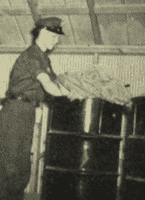 Dusted bags are placed in large drums of fumigants. Bags and fumigants are sealed in tanks with clamped lid. |
 Cleaned and fumigated bags are stacked awaiting shipment to mills. Bags are baled before they are shipped. This is at the Iroquois Service Company. |
| New feed bags were also in short supply. Jute used to make burlap feed bags was no longer available from India and the Maylay Peninsula. To deal with this shortage Illinois Farm Supply created a feed bag recycling program. Farmers were paid to turn back in their Blue Seal feed bags – eight cents for each burlap bag and five cents for each cotton bag. Equipment was set up at the Iroquois Service Company in Watseka to sort, clean, recondition and fumigate bags that were being recycled. The number of different size feed bags was reduced from 30 down to only six. The feed inside these recycled bags was probably not the feed name printed on the outside so a new tag system was implemented to identify the actual contents of each recycled bag. |
|
|
 James Talbott, employee of the Kendall Farmers Oil Company, adds another tire to the 12-ton scrap rubber pile built up by farmer patrons of the area. |
| Due to the rubber shortage, Farm Supply started a tire recapping service for its own vehicles, those of member companies and for Farm Bureau members when possible. Major rubber and scrap iron drives were also initiated and run in 1942 by the 575 truck salesmen of Farm Supply that sold the Blue Seal label. Farm Supply collected 2.25 million pounds of scrap iron and one million pounds of scrap rubber. An interesting side note – included in the rubber drive were four solid rubber tires weighing 34 pounds each from the Christian County Farm Supply Company. Solid rubber tires were used on Great Western autos from 1900-1910. |
| Illinois Producers Creameries also made war adjustments. Some dairies eliminated Sunday deliveries to save on gas and tires. Also five creameries purchased new equipment to begin the manufacture of powdered milk. Illinois Rural Youth conducted drives to collect scrap iron and rubber. In Peoria County the Rural Youth held a party called "The Junkman's Jubilee" where the price of admission was a piece of scrap rubber or iron. Victory gardens and ton-litter pigs programs were popular 4-H projects. The object of the ton-litter program was to have a litter of pigs weigh one ton within 180 days. The "Jap-Frying Pig Club" of Macoupin County participated in a Victory Sale at the National Stock Yards in October where farmers were paid in war bonds instead of cash. |
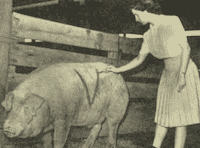 Miss Bonnie Sims of the Producers Live Stock Commission Association paints victory V on a 540-pound pig seat in by the Jap-Frying Pig club of Macoupin county. |
| This first chapter of Illinois Farm Bureau and World War II comes to a close at the 28th Annual Meeting in Chicago at the Hotel Sherman. At the opening on Thursday evening a silent tribute was made to the thousands of sons and daughters from Farm Bureau families that were protecting freedom around the globe. Heads were bowed as a soloist sang the National Anthem. The lights were dimmed and two spotlights pierced the darkness to highlight the service flags hanging above the speaker's table. To President Earl Smith's left hung a flag whose top star and number 3 indicated the number of Illinois Farm Bureau and affiliated company employees who had already died for the cause of freedom – the number 452 below indicated those who were willing to make that sacrifice if need be. To President Smith's right hung another service flag representing the men and women from Farm Bureau member's families. The top number read 58, the bottom number 15,578. |
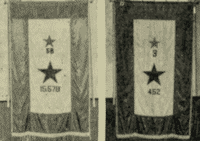 These two service flags honor the Farm Bureau boys and girls in service and the IAA, Farm Bureau and associated company employees in the armed forces. |
|
At the previous year's Annual Meeting President Smith said that… "They [farmers] will eagerly share with others any needed sacrifice for their country and they are ready, with others, to defend with force, if need be, American ideals and American institutions" These service flags were tangible evidence of that "needed sacrifice." |